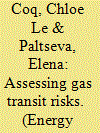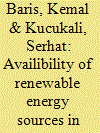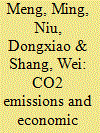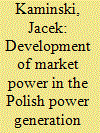|
|
|
Sort Order |
|
|
|
Items / Page
|
|
|
|
|
|
|
| Srl | Item |
| 1 |
ID:
111447


|
|
|
|
|
| Publication |
2012.
|
| Summary/Abstract |
The Intergovernmental Panel on Climate Change gave a methodology to estimate the methane emissions from Municipal Solid Wastes landfills, based on a First Order Decay (FOD) model that assumes biodegradation kinetics depending on the type of wastes. This model can be used to estimate both the National greenhouse gas emissions in the industrialized countries as well as the reductions of these emissions in the developing ones when the Clean Development Mechanism, as defined by the Kyoto Protocol, is implemented. In this paper, the FOD model has been use to evaluate the biogas flow rates emitted by a Brazilian landfill and the results have been compared to the extracted ones: some first results can be useful to evidence the weight of key parameters and do a correct use of the model.
|
|
|
|
|
|
|
|
|
|
|
|
|
|
|
|
| 2 |
ID:
111457


|
|
|
|
|
| Publication |
2012.
|
| Summary/Abstract |
This paper proposes a Transit Risk Index (TRI) designed to assess the riskiness of pipeline gas imports and to study the effect of introducing new gas routes. TRI controls for gas dependency, transit route diversification, political risks of transit, pipeline rupture probability, and the balance of power between supplying and consuming countries along the transit route. Evaluating TRI for the EU-Russia gas trade, we show that the introduction of the Nord Stream pipeline would further widen already large disparities in gas risk exposure across the EU Member States. The gas risk exposure of the Member States served by Nord Stream would decline. In contrast, EU countries not connected to Nord Stream, but sharing other Russian gas transit routes with the Nord Stream countries, would face greater gas risk exposure. We discuss the implications of our analysis for the design of the common energy policy in the EU.
|
|
|
|
|
|
|
|
|
|
|
|
|
|
|
|
| 3 |
ID:
111414


|
|
|
|
|
| Publication |
2012.
|
| Summary/Abstract |
Quantifying wind potential is a pivotal initial step in developing and articulating a state's policies and strategies for offshore wind industry development. This is particularly important in the Great Lakes States where lessons from other offshore environments are not directly applicable. This paper presents the framework developed for conducting a preliminary assessment of offshore wind potential. Information on lake bathymetry and wind resources were combined in simulating alternative scenarios of technically feasible turbine construction depths and distance concerns by stakeholders. These yielded estimates of developable offshore wind areas and potential power generation. While concerns about the visibility of turbines from shore reduce the power that can be generated, engineering solutions that increase the depths at which turbines can be sited increase such potential power output. This paper discusses the costs associated with technical limitations on depth and the social costs related to public sentiments about distance from the shoreline, as well as the possible tradeoffs. The results point to a very large untapped energy resource in the Michigan's Great Lakes, large enough to prompt policy action from the state government.
|
|
|
|
|
|
|
|
|
|
|
|
|
|
|
|
| 4 |
ID:
111430


|
|
|
|
|
| Publication |
2012.
|
| Summary/Abstract |
This study aims to explore the availability and potential of renewable energy sources in Turkey as well as assessing related government policies, financial and environmental aspects of renewable energy projects. Turkey is a country which has the highest hydropower, wind and geothermal energy potential among European countries. As a European Union (EU) candidate several incentives were developed in Turkey for electricity generation from renewable energy sources by the enactment of Law No. 5346 in 2005 which was later restructured by Law No. 6094 in 2010. The most important ones are: ease of land acquisition and feed-in-tariffs which promise purchasing of electricity generated and domestic manufacturing of equipment by the private companies with a price of 5.30-9.69 and 0.3-2.55 €c/kWh, respectively, depending on the type of the renewable and the equipment. However, feed-in tariff amounts take reservoir area into account instead of installed capacity for hydroelectric power plants. Moreover, Environmental Impact Assessment (EIA) report is not mandatory for all renewable energy plants. According to the multi-criteria analysis tool developed in this study to evaluate the renewable energy source (RES) technologies the most appropriate renewable energy alternative for Turkey is biomass, simply because of the highest social benefit among others.
|
|
|
|
|
|
|
|
|
|
|
|
|
|
|
|
| 5 |
ID:
111462


|
|
|
|
|
| Publication |
2012.
|
| Summary/Abstract |
Renewable energy is receiving increased attention as a viable alternative to non-renewable electrical generation, however, meeting global energy demands will require a more ambitious renewable energy program than is currently the case. There have been several reviews of potential technological, economic, social, or public barriers and solutions to renewable energy investment. Although important, there is also need for multi-dimensional analyses of these barriers and identification of the most significant underlying barriers if viable solutions are to be developed. In this paper we apply a theoretical framework to examine stakeholder's perceptions and understanding of the barriers to wind energy development in Saskatchewan, Canada. We identify and examine the most significant underlying barriers to investment in renewable energy and the interactions between those barriers. Results show a number of perceived barriers to wind energy investment, however, these barriers can be explained in large part by knowledge barriers, if not disagreement over whether the current level of investment in wind energy is sufficient. We show that barriers to renewable energy cannot be explained solely by technological, social, political, or economic factors in isolation, and that a multi-dimensional approach, identifying and explaining the underlying sources of these barriers, is necessary to develop viable solutions.
|
|
|
|
|
|
|
|
|
|
|
|
|
|
|
|
| 6 |
ID:
111402


|
|
|
|
|
| Publication |
2012.
|
| Summary/Abstract |
In the UK, the introduction of micro-generation Feed in Tariffs (FiTs) and a proposed Renewable Heat Incentive (RHI) for domestic and small scale schemes have re-energised the market for investment in domestic scale renewable energy. These incentives may provide financial opportunities for those with capital to spend but for the record numbers with low incomes in 'fuel poverty', these benefits may seem out of reach. This paper shows that with appropriate financial intermediaries it is possible for renewable energy incentives to be used to alleviate fuel poverty.
Simple financial analysis demonstrates the theoretical potential of FiTs to help those in fuel poverty. Two case studies of renewable energy projects in low income areas investigate how the incentives may be used in practice, what barriers exist and what success factors are evident. The analysis shows that local energy organisations (LEOs) are key if the poor are to access benefits from premium tariff schemes. Low interest finance mechanisms, good information sharing and community involvement are found as key success factors.
|
|
|
|
|
|
|
|
|
|
|
|
|
|
|
|
| 7 |
ID:
111415


|
|
|
|
|
| Publication |
2012.
|
| Summary/Abstract |
The growing concerns of global warming and climate change have forced water providers to scrutinize the energy for water production and the greenhouse gas (GHG) emissions associated with it. A system dynamics model is developed to estimate the energy requirements to move water from the water source to the distribution laterals of the Las Vegas Valley and to analyze the carbon footprint associated with it. The results show that at present nearly 0.85 million megawatt hours per year (MWh/y) energy is required for conveyance of water in distribution laterals of the Valley from Lake Mead resulting in approximately 0.53 million metric tons of CO2 emissions per year. Considering the current mix of fuel source, the energy and CO2 emissions will increase to 1.34 million MWh/y and 0.84 million metric tons per year, respectively, by the year 2035. Various scenarios including change in population growth rate, water conservation, increase in water reuse, change in the Lake level, change in fuel sources, change in emission rates, and combination of multiple scenarios are analyzed to study their impact on energy requirements and associated CO2 emissions.
|
|
|
|
|
|
|
|
|
|
|
|
|
|
|
|
| 8 |
ID:
111441


|
|
|
|
|
| Publication |
2012.
|
| Summary/Abstract |
Trades create a mechanism of embodied CO2 emissions transfer among regions, causing distortion on the total emissions. As the world's second largest economy, China has a large scale of trade, which results in the serious problem of embodied CO2 emissions transfer. This paper analyzes the characteristics of China's CO2 emissions embodied in international and interprovincial trade from the provincial perspective. The multi-regional Input-Output Model is used to clarify provincial CO2 emissions from geographical and sectoral dimensions, including 30 provinces and 28 sectors. Two calculating principles (production accounting principle and consumption accounting principle, Munksgaard and Pedersen, 2001) are applied. The results show that for international trade, the eastern area accounts for a large proportion in China's embodied CO2 emissions. The sectors as net exporters and importers of embodied CO2 emissions belong to labor-intensive and energy-intensive industries, respectively. For interprovincial trade, the net transfer of embodied CO2 emissions is from the eastern area to the central area, and energy-intensive industries are the main contributors. With the largest amount of direct CO2 emissions, the eastern area plays an important role in CO2 emissions reduction. The central and western areas need supportive policies to avoid the transfer of industries with high emissions.
|
|
|
|
|
|
|
|
|
|
|
|
|
|
|
|
| 9 |
ID:
111439


|
|
|
|
|
| Publication |
2012.
|
| Summary/Abstract |
For the period of the 12th Five-Year Plan (2011-2015), the Chinese government has decided to reconsider and adjust its policies on economic development because of the pressures of CO2 emissions and fossil energy consumption. The current paper adopts the logarithmic Stochastic Impacts by Regression on Population, Affluence, and Technology (STIRPAT) model to simulate the relationship between CO2 emissions and other economic development factors in China. Three groups of outliers are found using samples from 1989 to 2008 and the Partial Least Square (PLS) regularity test method. The outlier analysis reveals three important areas for CO2 reduction: (a) decreasing the share of coal to the total energy consumption and replacing it with non-fossil energies; (b) controlling vehicles used in the cities as well as (c) adjusting industrial structure. Furthermore, based on the social and economic realities of China, the current paper designs six feasible development scenarios for the period covered by the 12th Five-Year Plan and predicts the values of each factor in each scenario. The values can test the implementation of China's CO2 control development concept. The experiences obtained by outlier analysis can be of significant reference value for realizing the predicted scenarios.
|
|
|
|
|
|
|
|
|
|
|
|
|
|
|
|
| 10 |
ID:
111437


|
|
|
|
|
| Publication |
2012.
|
| Summary/Abstract |
In order to prevent the destabilisation of the Earth's biosphere, CO2 emissions must be reduced quickly and significantly. The causes of CO2 emissions by individual countries need to be apprehended in order to understand the processes required for reducing emissions around the globe. China and India are the two largest transitional countries and growing economies, but are in two entirely different categories in terms of structural changes in growth, trade and energy use. CO2 emissions from the burning of fossil fuels have significantly increased in the recent past. This paper compares China and India using the bounds testing approach to cointegration and the ARDL methodology to test the long- and short-run relationships between growth, trade, energy use and endogenously determined structural breaks. The CO2 emissions in China were influenced by per capita income, structural changes and energy consumption. A similar causal connection cannot be established for India with regard to structural changes and CO2 emissions, because India's informal economy is much larger than China's. India possesses an extraordinarily large number of micro-enterprises that are low energy consumers and not competitive enough to reach international markets. Understanding these contrasting scenarios is prerequisite to reaching an international agreement on climate change affecting these two countries.
|
|
|
|
|
|
|
|
|
|
|
|
|
|
|
|
| 11 |
ID:
111458


|
|
|
|
|
| Publication |
2012.
|
| Summary/Abstract |
In Iran, there are more than 15,000 MW of wind power potential, but only about 90 MW have been installed since 2009. Because fuel costs are the main part of fuel-consumed power generation costs and fossil resource costs are highly subsidized in Iran, renewable energies such as wind power have yet to be fully developed. This analysis sets out to evaluate the total generating costs of wind power and conventional power plants in Iran. A levelized cost approach was conducted that included investment costs, O&M costs, fuel costs and external costs of emissions for each type of technology. Comparison of cost assessments of power generation show that by taking into account global fuel prices and incorporating air pollutant externalities, wind power can be as competitive as conventional power plants. This paper suggests that a subsidies targeting law would significantly affect the development of the Iranian wind power industry in the future.
|
|
|
|
|
|
|
|
|
|
|
|
|
|
|
|
| 12 |
ID:
111397


|
|
|
|
|
| Publication |
2012.
|
| Summary/Abstract |
To-date, decomposition analysis has been widely used at the macro-economic level and for in-depth analyses of the industry and transport sectors; however, its application in the residential sector has been rare. This paper uses the Log-Mean Divisia Index I (LMDI-I) methodology to decompose gas consumption trends in the gas-connected residential sector in Ireland from 1990 to 2008, which despite an increasing number of energy efficiency policies, experienced total final consumption growth of 470%. The analysis decomposes this change in gas consumption into a number of effects, examining the impact over time of market factors such as a growing customer base, varying mix of dwelling types, changing share of vacant dwellings, changing size of new dwellings, the impact of building regulations policy and other factors such as the weather. The analysis finds the most significant effects are changing customer numbers and changing intensity; the analysis also quantifies the impact of building regulations and compares it with other effects such as changing size of new dwellings. By comparing the historical impact on gas consumption of policy factors and non-policy factors, this paper highlights the challenge for policy-makers in achieving overall energy consumption reduction.
|
|
|
|
|
|
|
|
|
|
|
|
|
|
|
|
| 13 |
ID:
111411


|
|
|
|
|
| Publication |
2012.
|
| Summary/Abstract |
Electricity is the guarantee of normal life, and the electricity price is widely concerned. As a developing country in the transition stage, abundant policy implications are included in the electricity price in China, thus, whether to adjust the resident electricity price is a dilemma for the government. However, the current single tariff system cannot cope with the complex social and environmental problems. A new price mechanism is indeed needed. This paper tries to design an increasing block tariffs system with the consideration of residential income and electricity consumption. The result indicates that the increasing block tariffs system with four-tier structure is more reasonable for China. Although the increasing block tariffs will result in the increase of electricity price, it is still acceptable and affordable. The increasing block tariffs will greatly improve the equity and efficiency, and promote the electricity saving and emissions reduction. Moreover, the power companies will increase tariffs revenue, which would use to the transmission networks investment in poor area. In order to the offset the limitations of the increasing block tariffs, the government should adopt some complementary measures.
|
|
|
|
|
|
|
|
|
|
|
|
|
|
|
|
| 14 |
ID:
111454


|
|
|
|
|
| Publication |
2012.
|
| Summary/Abstract |
Sustainable Development (SD) has played a major role as a foundation of several policy making frameworks developed mainly by international organizations. In this paper, some critical points regarding the origination and formulation of the SD concept are discussed. It is argued that the SD concerns with selected sectors and regions rather than the whole society and all regions of the world. To tackle these shortcomings, the conventional definition of SD is extended in this paper according to a broad philosophy of harmonizing key aspects of human, nature and systems performances over generations. Based on this extended definition, an improved Driving Force-State-Response (DSR-HNS) policy making framework is introduced. The main contribution is the modeling of the state block by human, nature and systems components to design overall and coherent policies. A procedure using the framework is also elaborated to monitor the current policies and design new ones, which provides a dynamic, nonlinear, feedback controlled policy making practice, not accommodated by existing policy making frameworks. Finally, a case study is presented to evaluate the effectiveness of the modified framework and the proposed model. The study assesses Iran's electric power generation system from sustainability point of view and develops new policies.
|
|
|
|
|
|
|
|
|
|
|
|
|
|
|
|
| 15 |
ID:
111421


|
|
|
|
|
| Publication |
2012.
|
| Summary/Abstract |
Climate warming is expected to alter hydropower generation in California through affecting the annual stream-flow regimes and reducing snowpack. On the other hand, increased temperatures are expected to increase hydropower demand for cooling in warm periods while decreasing demand for heating in winter, subsequently altering the annual hydropower pricing patterns. The resulting variations in hydropower supply and pricing regimes necessitate changes in reservoir operations to minimize the revenue losses from climate warming. Previous studies in California have only explored the effects of hydrological changes on hydropower generation and revenues. This study builds a long-term hydropower pricing estimation tool, based on artificial neural network (ANN), to develop pricing scenarios under different climate warming scenarios. Results suggest higher average hydropower prices under climate warming scenarios than under historical climate. The developed tool is integrated with California's Energy-Based Hydropower Optimization Model (EBHOM) to facilitate simultaneous consideration of climate warming on hydropower supply, demand and pricing. EBHOM estimates an additional 5% drop in annual revenues under a dry warming scenario when climate change impacts on pricing are considered, with respect to when such effects are ignored, underlining the importance of considering changes in hydropower demand and pricing in future studies and policy making.
|
|
|
|
|
|
|
|
|
|
|
|
|
|
|
|
| 16 |
ID:
111408


|
|
|
|
|
| Publication |
2012.
|
| Summary/Abstract |
The paper examines how and to which extent consolidation in the Polish power generation sector has affected the potential for market power over the last 10 years. Although this sector has been undergoing liberalisation (privatisation, introduction of TPA regulations and competition etc.), the consolidation efforts shown by Polish governments have resulted in a significant increase in concentration of both installed capacity and production. The methodology applied in this study includes typical ex-post structural and behavioural measures employed to estimate potential for market power, namely: concentration ratios (for the largest and the three largest suppliers), the Herfindahl-Hirschman Index, entropy, Supply Margin Assessment, the Residual Supply Index and the Lerner Index. Furthermore, an analysis based on the Gini coefficient was employed to obtain an insight into inequalities. The results of this study show that governmental decisions led to a significant increase in the potential to exercise market power held by key power generation companies. Of key importance was the 2007 consolidation, resulting in an increase in the HHI to 1374 (in terms of installed capacity) and 1945 (in terms of electricity production). This consolidation resulted in the creation of the first Pivotal Supplier in the Polish power generation sector in 2008.
|
|
|
|
|
|
|
|
|
|
|
|
|
|
|
|
| 17 |
ID:
111450


|
|
|
|
|
| Publication |
2012.
|
| Summary/Abstract |
Although the benefits of distributed cogeneration are widely cited, adoption has been slow in the United States. Adoption could be encouraged by making cogeneration more economically attractive, either by increasing the expected returns or decreasing the risks of such investments. We evaluate the expected returns from demand response, capacity markets, regulation markets, accelerated depreciation, pricing CO2 emissions, and net metering. We find that (1) there is an incentive to overcommit in the capacity market due to lenient non-response penalties, (2) there is significant revenue potential in the regulation market, though demand-side resources are yet to participate, (3) a price on CO2 emissions will make cogeneration more attractive relative to conventional, utility-supplied energy, and (4) accelerated depreciation is an easy and effective mechanism for improving the economics of cogeneration. We go on to argue that uncertainty in fuel and electricity prices present a significant risk to cogeneration projects, and we evaluate the effectiveness of feed-in tariffs at mitigating these risks. We find that guaranteeing a fixed electricity payment is not effective. A two-part feed-in tariff, with an annual capacity payment and an energy payment that adjusts with fuel costs, can eliminate energy-price risks.
|
|
|
|
|
|
|
|
|
|
|
|
|
|
|
|
| 18 |
ID:
111432


|
|
|
|
|
| Publication |
2012.
|
| Summary/Abstract |
A practical mathematical programming model for the strategic fuel diversification problem is presented. The model is designed to consider the tradeoffs between the expected costs of investments in capacity, operating and maintenance costs, average fuel costs, and the variability of fuel costs. In addition, the model is designed to take the load curve into account at a high degree of resolution, while keeping the computational burden at a practical level.
The model is illustrated with a case study for Indiana's power generation system. The model reveals that an effective means of reducing the volatility of the system-level fuel costs is through the reduction of dependence on coal-fired generation with an attendant shift towards nuclear generation. Model results indicate that about a 25% reduction in the standard deviation of the generation costs can be achieved with about a 20-25% increase in average fuel costs. Scenarios that incorporate costs for carbon dioxide emissions or a moratorium on nuclear capacity additions are also presented.
|
|
|
|
|
|
|
|
|
|
|
|
|
|
|
|
| 19 |
ID:
111413


|
|
|
|
|
| Publication |
2012.
|
| Summary/Abstract |
We model the dynamically optimal oil production on Iran's offshore Soroosh and Nowrooz fields, which have been developed by Shell Exploration through a buy-back service contract. In particular, we examine the National Iranian Oil Company's (NIOC) actual and contractual oil production behavior and compare it to the production profile that would have been optimal under the conditions of the contract. We find that the contract's production profile is different from optimal production profile for most discount rates, and that the NIOC's actual behavior is inefficient-its production rates have not maximized profits. Because the NIOC's objective is purported to be maximizing cumulative production instead of the present discounted value of the entire stream of profits, we also compare the NIOC's behavior to the production profile that would maximize cumulative production. We find that even though what the contract dictates comes close to maximizing cumulative production, the NIOC has not been achieving its own objective of maximizing cumulative production.
|
|
|
|
|
|
|
|
|
|
|
|
|
|
|
|
| 20 |
ID:
111435


|
|
|
|
|
| Publication |
2012.
|
| Summary/Abstract |
Energy policies that aim to reduce carbon emissions and change the mix of electricity generation sources, such as carbon cap-and-trade systems and renewable electricity standards, can affect not only the source of electricity generation, but also the price of electricity and, consequently, demand. We develop an optimization model to determine the lowest cost investment and operation plan for the generating capacity of an electric power system. The model incorporates demand response to price change. In a case study for a U.S. state, we show the price, demand, and generation mix implications of a renewable electricity standard, and of a carbon cap-and-trade policy with and without initial free allocation of carbon allowances. This study shows that both the demand moderating effects and the generation mix changing effects of the policies can be the sources of carbon emissions reductions, and also shows that the share of the sources could differ with different policy designs. The case study provides different results when demand elasticity is excluded, underscoring the importance of incorporating demand response in the evaluation of electricity generation policies.
|
|
|
|
|
|
|
|
|
|
|
|
|
|
|
|
|
|
|
|
|